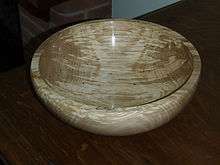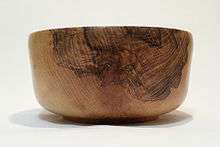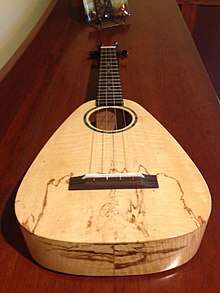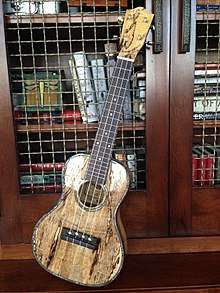Spalting
Spalting is any form of wood coloration caused by fungi. Although primarily found in dead trees, spalting can also occur in living trees under stress. Although spalting can cause weight loss and strength loss in the wood, the unique coloration and patterns of spalted wood are sought by woodworkers.[1]





Types
Spalting is divided into three main types: pigmentation, white rot, and zone lines. Spalted wood may exhibit one or all of these types in varying degrees. Both hardwoods (deciduous) and softwoods (coniferous) can spalt, but zone lines and white rot are more commonly found on hardwoods due to enzymatic differences in white rotting fungi. Brown rots are more common to conifers, although one brown rot, Fistulina hepatica (beefsteak fungus), is known to cause spalting.[2]
Pigmentation
Pigmentation is caused when fungi produce extracellular pigments inside wood. Bluestain is also a form of pigmentation, however generally bluestain pigments are bound within the hyphae cell walls.[3][4] A visible color change can be seen if enough hyphae are concentrated in an area.[5] Pigmenting fungi classified as spalting fungi do decay wood, they simply do so at a slower rate (soft rotting) than white rotting fungi.[6][7] The most common groups of pigmentation fungi are the imperfect fungi and the ascomycetes.[8] Mold fungi, such as Trichoderma spp., are not considered to be spalting fungi, as their hyphae do not colonize the wood internally and they do not produce the enzymes necessary to digest the wood cell wall components.
White rot
The mottled white pockets and bleaching effect seen in spalted wood is due to white rot fungi. Primarily found on hardwoods, these fungi "bleach" by consuming lignin, which is the slightly pigmented area of a wood cell wall.[9] Some white rotting can also be caused by an effect similar to pigmentation, in which the white hyphae of a fungus, such as Trametes versicolor (Fr.) Pil., is so concentrated in an area that a visual effect is created.[10]
Both strength and weight loss occur with white rot decay, causing the "punky" area often referred to by woodworkers. Brown rots, the "unpleasing" type of spalting, do not degrade lignin, thus creating a crumbly, cracked surface which cannot be stabilized.[5] Both types of rot, if uncontrolled, will render wood useless.
Zone lines
Dark dotting, winding lines and thin streaks of red, brown and black are known as zone lines. This type of spalting does not occur due to any specific type of fungus, but is instead an interaction zone in which different fungi have erected barriers to protect their resources.[8] They can also be caused by a single fungus delineating itself. The lines are often clumps of hard, dark mycelium, referred to as pseudosclerotial plate formation.[11]
Zone lines themselves do not damage the wood. However, the fungi responsible for creating them often do. Spalted wood is also sometimes known as web wood.
Conditions
Conditions required for spalting are the same as the conditions required for fungal growth: fixed nitrogen, micronutrients, water, warm temperatures and oxygen.[5][12]
Water: Wood must be saturated to a 20% moisture content or higher for fungal colonization to occur. Wood placed underwater lacks sufficient oxygen, and colonization cannot occur.[13]
Temperature: The majority of fungi prefer warm temperatures between 10 and 40 °C,[13] with rapid growth occurring between 20 and 32 °C.[14]
Oxygen: Fungi do not require much oxygen, but conditions such as waterlogging will inhibit growth.[15][16]
Time: Different fungi require different amounts of time to colonize wood. Research conducted on some common spalting fungi found that Trametes versicolor, when paired with Bjerkandera adusta, took eight weeks to spalt 1.5 inch (38 mm) cubes of Acer saccharum.[1] Colonization continued to progress after this time period, but the structural integrity of the wood was compromised. The same study also found that Polyporus brumalis, when paired with Trametes versicolor, required 10 weeks to spalt the same size cubes.
Commonly spalted woods
The Ohio Department of Natural Resources found that pale hardwoods had the best ability to spalt.[17] Some common trees in this category include maple (Acer spp.), birch (Betula spp.) and beech (Fagus spp.). However, recent research suggests that sugar maple (Acer saccharum) and aspen (Populus sp.) are preferred by both white rot and pigment fungi.[18][19]
Common spalting fungi
One of the trickier aspects to spalting is that some fungi cannot colonize wood alone; they require other fungi to have preceded them to create favorable conditions. Fungi progress in waves of primary and secondary colonizers,[4] where primary colonizers initially capture and control resources, change the pH of the wood and its structure, and then must defend against secondary colonizers that then have the ability to colonize the substrate.[4][20]
Ceratocystis spp. (Ascomycetes) contains the most common blue stain fungi.[21] Other pigmenting fungi include Chlorociboria aeruginascens, Chlorociboria aeruginosa, Scytalidium cuboideum, and Scytalidium ganodermopthorum.[22] Trametes versicolor, (Basidiomycetes) is found all over the world and is a quick and efficient white rot of hardwoods.[4] Xylaria polymorpha (Pers. ex Mer.) Grev. (Ascomycetes) has been known to bleach wood, but is unique in that it is one of the few fungi that will erect zone lines without any antagonism from other fungi.[23]
Research
Initial lab work was conducted on spalting in the 1980s at Brigham Young University. A method for improving machinability in spalted wood using methyl methacrylate was developed in 1982,[24] and several white rot fungi responsible for zone line formation were identified in 1987.[25] Current research at Michigan Technological University has identified specific time periods at which certain spalting fungi will interact, and how long it takes for said fungi to render the wood useless.[1] Researchers from this university also developed a test for evaluating the machinability of spalted wood using a universal test machine.[26]
References
- Robinson, S.C.; Richter, D.L.; Laks, P.E. (2007-04-01). "Colonization of sugar maple by spalting fungi". Forest Products Journal (April 2007). Retrieved 2008-11-25.
- Robinson, Sara (2009-04-14). "Spalted wood: Find out how wood and fungi interact to create beautiful boards". Fine Woodworking. Taunton Press. Retrieved 2009-10-08.
- Journal of the Institute of Wood Science 14, 18-29.
- Rayner, A.D.M., and Boddy, L. (1988). Fungal Decomposition of Wood. Its biology and Ecology. John Wiley and Sons: New York.
- Zabel, R.A., and Morrell, J.J. (1992). Wood Microbiology. Decay and Its Prevention. Harcourt Brace Jovanovich, Academic Press, INC: New York
- Richter, D.L., and Glaeser, J.A. 2015. Wood decay by Chlorociboria aeruginascens (Nyl.) Kanas (Helotiales, Leotiaceae) and associated basidiomycete fungi. International Biodeterioration & Biodegradation 105:239-244.
- Anagnost, S.E., Worrall, J.J., and Wang, C.J.K. 1994. Diffuse cavity formation in soft rot of pine. Wood Science and Technology 28(3):199-208
- Rayner, A.D.M., and Todd, N.K. (1982). Population Structure in Wood-Decomposing Basidiomycetes. Cambridge University Press: New York.
- Liese, W. (1970). Ultrastructural aspects of woody-tissue disintegration. Annual Review of Phytopathology 8, 231-257.
- Blanchette, R.A. (1984). Screening wood decayed by white rot fungi for preferential lignin degradation. Applied and Environmental Microbiology 48 (3), 647-653.
- Cease, K.R., Blanchette, R.A., and Highley, T.L. (1989). Interactions between Scytalidium species and brown- or white-rot Basidiomycetes in birch wood. Wood Science and Technology 23, 151-161
- Manion, P.D. (1991). Tree Disease Concepts. 2nd ed. Prentice-Hall: New Jersey
- Eaton, R.A., and Hale, M.D.C. (1993). Wood: Decay, Pests, and Protection. Chapman & Hall: New York.
- Humphrey, C.J., and Siggers, P.V. (1933). Temperature relations of wood-destroying fungi. Journal of Agricultural and Resource Economics 47, 997-1008.
- Fogarty, W.M., & Ward, O.P. (1973). Growth and enzyme production by Bacillus subtilius and Flavobacterium pectinovorum in Picea sitchensis. Wood Science and Technology 7, 261-270.
- Van der Kamp, B.J., Gokhale, A.A., and Smith, R.S. (1979). Decay resistance owing to near-anaerobic conditions in black cottonwood wetwood. Canadian Journal of Forest Research 9(1), 39-44.
- Ohio Department of Natural Resources. (2005). Spalted Wood. Division home page: Forest Industries.
- Robinson, S.C., Laks, P.E. (2010a). Wood species affects colonization rates of Chlorociboria sp. International Biodeterioration & Biodegradation 64:305-308.
- Robinson, S.C., Laks, P.E. (2010b). Culture age and wood species affect zone line production of Xylaria polymorpha. The Open Mycology Journal in press.
- Holmer, L., Renvall, P., & Stenlid, J. (1997). Selective replacement between species of wood-rotting Basidiomycetes, a laboratory study. Mycological Research 6, 714-720.
- Croan, S.C. (2000). Evaluation of white-rot fungal growth on Southern Yellow Pine wood chips pretreated with blue-stain fungi. The International Research Group on Wood Preservation: U.S. Department of Agriculture, Forest Service. 31st Meeting.
- Robinson, Sara C. (2012-01-13). "Developing fungal pigments for "painting" vascular plants". Applied Microbiology and Biotechnology. 93 (4): 1389–1394. doi:10.1007/s00253-011-3858-2. ISSN 0175-7598.
- Campbell, A.H. (1933). Zone lines in plant tissues. I. The black lines formed by Xylaria polymorpha (Pers.) Grev. in hardwoods. Annals of Applied Biology 21, 1-22.
- Christensen, K.W. (1982). Improving the Working Properties of Spalted Woods Through Impregnation with Methyl Methacrylate. Thesis: Brigham Young University.
- Phillips, L.W. (1987). The Nature of Spalted Wood: Analysis of Zone Line Formation Between Six White Rot Fungi. Thesis: Brigham Young University.
- Robinson, S.C., Laks, P.E., Richter, D.L. and Pickens, J. B. (2007). Evaluating loss of machinability in spalted sugar maple. Forest Products Journal 57(4), 33-37.